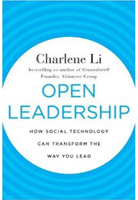 Am reading an excellent book at the moment – Open Leadership by Charlene Li.
Am reading an excellent book at the moment – Open Leadership by Charlene Li.
Fans of dead-tree web 2.0 reading will be familiar with Groundswell, which Li co-authored and was chock-full of interesting case studies – mostly from the US private sector – around how collaborative relationships with customers, often using the web as a platform, lead to success.
Here’s some of the blurb for Open Leadership:
Open Leadership reveals step-by-step, with illustrative case studies and examples from a wide-range of industries and countries, how to bring the precision of this new openness to both inside and outside the organization. The author includes suggestions that will help an organization determine an open strategy, weigh the benefits against the risk, and have a clear understanding of the implications of being open. The book also contains guidelines, policies, and procedures that successful companies have implemented to manage openness and ensure that business objectives are at the center of their openness strategy.
It’s a great read too. One of my favourite bits is where Li lists early on five new rules for leaders to bear in mind when managing relationships:
- Respect that your customers and employees have power
- Share constantly to build trust
- Nurture curiosity and humility
- Hold openness accountable
- Forgive failure
Hear, hear!
You can get a flavour of the book with this free snippet:
